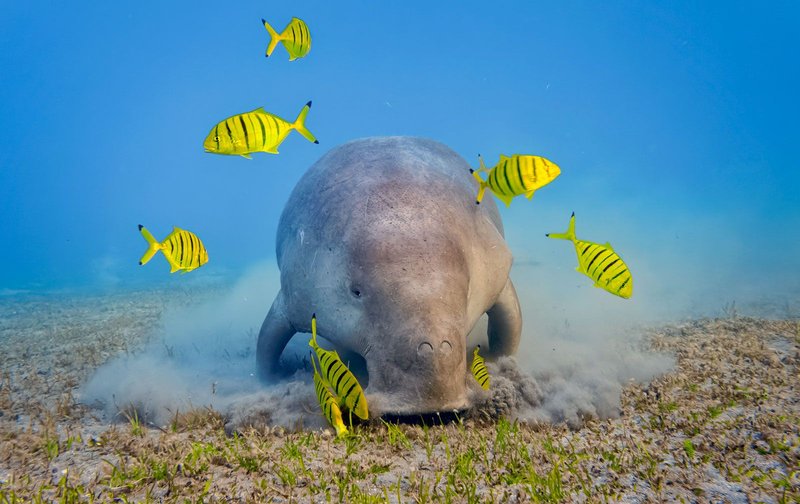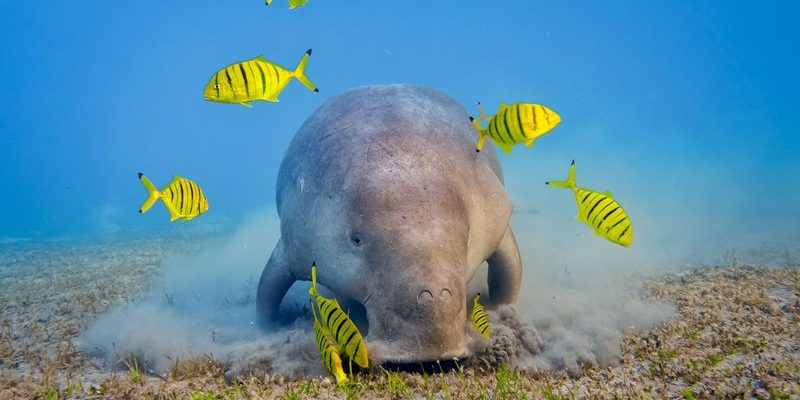
To put it simply, dugongs are marine mammals found in shallow coastal waters, primarily in the tropical and subtropical regions. Think of these areas as dugong’s cozy neighborhoods, where the water is just right for them to thrive. They have their favorite hangouts, but their population is not as widespread as you might think. This means that understanding their habitat and distribution is key to learning how to protect them.
What Exactly Is a Dugong?
Dugongs (Dugong dugon) are not your typical marine animals. They belong to the order Sirenia, which also includes manatees. These bulbous creatures can grow up to 10 feet long and weigh as much as 1,100 pounds! You might wonder why they look so unique. Well, their bodies are streamlined for swimming, with a fluked tail similar to that of a whale. Their skin is grayish-brown, often covered with barnacles and algae, giving them an earthy appearance.
Besides their looks, what sets dugongs apart is their diet. Unlike many marine animals that feast on fish and other sea creatures, dugongs love seagrass. They graze on these underwater plants, which they help maintain by preventing overgrowth. Imagine them as natural lawnmowers of the ocean floor, playing a crucial role in the marine ecosystem.
Dugong Distribution: Where to Find Them
Dugongs are predominantly found in warm coastal waters across the Indian and Pacific Oceans. You might find them along the coastlines of countries like Australia, the Philippines, and even parts of East Africa. However, these gentle giants don’t just roam anywhere. They prefer shallow, sheltered areas where seagrass beds are abundant.
Some key regions include:
- The Great Barrier Reef in Australia
- The Red Sea
- The waters around the Arabian Peninsula
- The coastlines of East Africa
- The seas around the Caribbean
Here’s the thing: while they have a wide range, dugong populations are relatively sparse. They aren’t as common as you might think, and many factors contribute to their declining numbers.
Why Are Dugong Habitats Important?
Dugong habitats are not just home sweet home; they provide essential ecosystem services. The seagrass beds they rely on are vital for various marine life, acting as nursery grounds for fish and other aquatic species. When dugongs graze on these grasses, they promote healthy growth and biodiversity. It’s a beautiful cycle—by munching on plants, they help maintain the health of the underwater landscape.
Additionally, seagrass beds help stabilize the ocean floor, preventing erosion and improving water quality. This means that protecting dugongs and their habitats is essential not just for their survival but for the health of the entire marine ecosystem. Imagine you’re nurturing a garden; if you take care of the plants, the whole garden flourishes.
Threats to Dugongs and Their Habitats
Unfortunately, dugongs face several threats that endanger their habitats. One of the biggest challenges is habitat loss due to coastal development, pollution, and climate change. As coastal areas get developed, seagrass beds are destroyed, which means dugongs have fewer places to thrive.
The impacts of pollution can be devastating too. Chemicals and waste runoff can harm the delicate balance of their habitats, leading to diminishing seagrass health. Additionally, *boat strikes* are a significant risk, as these gentle creatures can be injured or killed by passing vessels.
Other issues include overfishing and entanglement in fishing gear, which disrupt the delicate ecosystems dugongs rely on. This situation raises an important question: how do we protect these magnificent animals and their habitats?
Conservation Efforts for Dugongs
Many organizations and governments are working hard to protect dugongs and their habitats. Conservation efforts typically focus on *protecting seagrass beds*, raising awareness about these unique creatures, and establishing marine protected areas.
Here are a few strategies being employed:
- Marine Protected Areas: These zones restrict human activities in certain regions, allowing marine life to thrive.
- Public Awareness Campaigns: Educating communities about the importance of dugongs helps foster respect and protection for these animals.
- Research and Monitoring: Ongoing studies help us understand dugong populations and habitat health, guiding conservation strategies.
These efforts are crucial because, as responsible inhabitants of our planet, it’s our duty to care for the creatures that share our oceans. By protecting dugongs, we also ensure the health of marine ecosystems that countless species rely on.
How You Can Help Dugongs
You might be wondering how you can contribute to the conservation of dugongs. The good news is that every little action counts! Here are some simple ways you can make a difference:
- Support Marine Conservation Organizations: Donating to or volunteering with organizations focused on marine life can have a significant impact.
- Practice Sustainable Fishing: If you fish, make sure to follow regulations and avoid practices that harm marine life.
- Reduce Plastic Use: Reducing your plastic consumption helps decrease ocean pollution, benefiting all marine creatures.
- Spread the Word: Share information about dugongs and their habitats to help raise awareness in your community.
By taking these steps, you can play a part in the ongoing efforts to protect dugongs and their essential habitats.
Dugongs might not be household names like dolphins or turtles, but they are fascinating creatures that play a vital role in our oceans. Their habitats, rich with seagrass, provide essential services that benefit numerous marine species. By understanding where dugongs live and the challenges they face, we can work together to ensure their survival.
So next time you hear about dugongs, think of them as gentle giants gliding through their underwater gardens. Protecting their homes means protecting the health of our oceans. Let’s be their caretakers!

